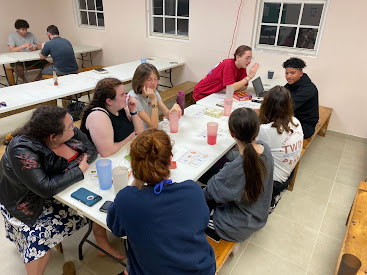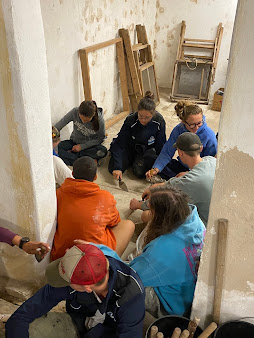Archaeology at the Globe Museum - Digital and Actual, Part I
The University of Rochester Spring Break fieldwork week started with some bumps and bruises - several students were delayed several days getting to Bermuda (thanks, DELTA!) and over the week we had up to gale-force winds, which made getting to and from our homes on Paget Island both wet and challenging. A total of 20 students (and my boss, History Department Chair Ruben Flores) did an amazing amount of work in a mere week's time despite various hiccups, curve-balls, rainstorms, and invasions, and I am enormously grateful to each and every one of them for their work, patience, and good spirits - Sophia, Clarice, Dariel, Ruben, Paola, Elvis, Matt, Andrew, Skylar, Megan, Tara, Fagaye, Natasha, Nora, Cameron, Lizzy, Katie, and (not pictured) Megan, Isabel, Keegan, and Mary.
It was a truly packed week of creative chaos and improvisation in terms of research, education, and living conditions. We stayed at the Bermuda Government camp facility on Paget Island and enjoyed very lively commutes to work across a whitecap-filled harbour. Luckily, we had a larger boat than I usually have in the summer, and can honestly say that without it, we would have spent most of the week confined to Paget by the weather (Thanks BAMZ and Ian!!!). Although I found the weather cool (and Bermudians were bundled up and freezing), I was impressed that most days most students went to the beach after work for a swim! This blog is a week late because we had no wifi on Paget, but this just led students to play card games and have movie nights (Twilight, anyone?), which was great to see. We cooked communally most nights but also very much enjoyed and benefitted from Somers Market's generous donations of its hot food bar extras each evening. Various student chefs made spaghetti, chili, korma curry, gumbo, and lots of grilled cheese sandwiches (pro-tip: mayonnaise!) while I played short-order cook one night slinging burgers, hot dogs, and fries.
 As we settled in, we noticed a lot of other students milling around King's Square (drawn there by the free wifi), whom we discovered were attached to the Pelican of London, a a beautiful German sail-training vessel tied up at Tiger Bay. They had been sailing since October and were home-bound when their generator died, and were now stranded until it could be fixed.
As we settled in, we noticed a lot of other students milling around King's Square (drawn there by the free wifi), whom we discovered were attached to the Pelican of London, a a beautiful German sail-training vessel tied up at Tiger Bay. They had been sailing since October and were home-bound when their generator died, and were now stranded until it could be fixed.While the archaeology students divided into four teams, each with their own room to excavate, the Digital History/Archaeology students got a crash course in photogrammetry image-taking in the square and then were sent out to actually record the houses that they had already come to know very well after a month of doing historical research on them. Katie went with them to initiate them in the art and mystery of photo surveys. Before morning's end, they learned that "soft skills" and interpersonal interaction are as vital as a good camera and comosition framing; while some St. Georgians proved curious about their research and friendly (in one case perhaps TOO friendly...), others closed their doors and let loose dogs in their yards. Most of St. George's is of course private property, so we necessarily rely on good will to record and study its many historic houses.
Meanwhile, back at the Globe the teams were each prepping their areas for excavation - drawing plans of the flagstones, filling out context sheets, and establishing a datum and opening elevations. We all held our breaths to see what would be under the stone flooring: a bedding layer of sand and, in many cases, letters or numerals inscribed on the undersides of the stones. One stone even featured a broad arrow and an "N" - a compass ordinal marker from the original Dockyard or Barracks Hill location from whence the Bermuda National Trust likely obtained suitably old flooring material.




And then the children began to arrive... The Bermuda National Trust and Ministry of Education teamed up to use our excavations as a unique "teachable moment" opportunity to show elementary and middle school students "archaeology in action" by bringing them to our site throughout the week. UR students stepped up to give guided tours of the groups, explain how archaeologists work and how our work complements history, and discuss what we were finding. Most were disappointed to learn we had found neither gold nor skeletons under the floors but many grasped the importance of learning about past Bermudians whose lives are undocumented, in many cases their ancestors.





















.jpg)
Comments